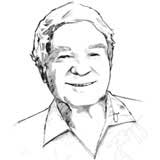Ain’t Seen Nothing Yet
DROP THAT DRATTED PHONE: She came sailing down APS, head turned away from us, cell phone glued to her ear. Her mouth was moving a mile a minute and so was her car, bearing down on us lickety-split on the five-points roundabout. She apparently didn’t know or didn’t care that in a roundabout, you must yield to cars on your left. She didn’t, so we stopped, not on that day willing to have her crash into us. She sped on her way, blissfully unaware.

Now, this happens there every day. But at least, as of July 1, using a hand-held cell phone will be illegal. Fine: $20 plus much more in fees (and possible liability) in case of an accident.
YOU THINK THAT WAS HOT HERE? Imagine yourself back on June 17, 1859, when the mercury soared to an unbelievable 133 degrees in Santa Barbara. Look, I’m at least as skeptical as the next guy and tend to question those old-timers’ stories of the coldest winter, wettest day, blah, blah. But it just so happened that a U.S. Coast Survey engineering vessel was in the Santa Barbara Channel that day and recorded the killing temperature, local historian Walker Tompkins wrote in his book It Happened in Old Santa Barbara. That stood as a record in the official books until 1934, when it hit 134 in (surprise) Death Valley. That day in June 1859, the Santa Barbara morning started out quite warm. Then a blast of super-hot wind hit town at around 1 p.m., “taking a terrible toll of the beasts of the field, leaving the buzzards a feast of calves, rabbits, field mice, and even full-grown cattle,” Tompkins wrote. According to accounts, by 2 p.m. the sun “was reduced to a glowing copper rivet in the sky” and the temperature hit 133. Residents took refuge inside, behind thick adobe walls, and there are no reports of human deaths. But later that day, as residents crept outside, they found that birds had “plummeted, asphyxiated, from the sky and dotted the ground.” By sundown, it was 77 degrees. Fearful residents awaited a second day of firestorm, but no second simoon came. Could there be a second blowtorch visit some day?
LAWYERS COMMENT: After my item last week about the Santa Barbara News-Press‘s $140,000 settlement with employees over vacation and overtime claims, I heard from a very unhappy NP attorney, Barry Cappello.
“Your column on the Medina class action that the News-Press recently settled completely missed the point. The News-Press wasn’t defeated, forced to settle because of the suit, or anything of the kind. Mrs. McCaw and the News-Press decided that the lawsuit disclosed a claim which needed investigation. When our firm completed that investigation it was clear that prior to Mrs. McCaw assuming a role as copublisher, prior management had utterly failed to both record and pay vacation and overtime benefits to many newsroom employees, as the law required.
“Rather than engage in litigation for the sake of spite, greed, or any other false motive, we recommended and the copublishers agreed that these employees had the right to these monies. Despite the fact that many were Teamster members and/or virulently anti-News-Press, fairness dictated the matter be settled quickly by paying the back wages owned. No histrionics, no anti-union rhetoric, no ‘kill them with litigation’ tactics. The decision to settle was simply plain, standard, and sound legal advice.”
Ira Gottlieb, Teamsters’ attorney, told me that he was glad that “for once” the paper was apparently willing to settle. “That has not been the standard operating procedure for the News-Press in the last two years or so :”
Cappello also hailed a federal judge’s recent ruling against allowing the fired reporters to return to work pending the ongoing News-Press appeal, saying it vindicated the paper’s overall position. The union disagrees with the ruling “and has urged the NLRB to appeal it,” Gottlieb said. A National Labor Relations Commission judge has ruled that the reporters were illegally fired. Meanwhile, snail-paced bargaining between the newsroom union and management goes on, “though the News-Press continues to demonstrate its bad faith in a variety of ways that are still under investigation and deliberation by the NLRB,” Gottlieb said.
TAINTED TOBACCO MONEY: Democrat Hannah-Beth Jackson, running for the state senate, is challenging GOP opponent Tony Strickland to return money he received from the tobacco industry. She pointed out that “over 440,000 Americans die early, costly, preventable deaths from tobacco” every year. She says the tobacco industry gave him more than $6,000 directly for his current campaign, plus $50,000 the Ventura County Republican Party “clearly earmarked” for his campaign, and “over $85,000 his campaign committees have received during his Assembly career.” Meanwhile, Tony’s wife, Assemblymember Audra Strickland, placed her chief of staff on “a one-month leave of absence without pay” after a pro-Jackson demonstrator, a Vietnam vet, was apparently elbowed to the ground by the staffer during a scuffle.



